Characterizations of Cuprous Oxide Thin Films Prepared by Sol-Gel Spin Coating Technique with Different Additives for the Photoelectrochemical Solar Cell
Abstract
Cuprous oxide (Cu2O) thin films were deposited onto indium tin oxide (ITO) coated glass substrate by sol-gel spin coating technique using different additives, namely, polyethylene glycol and ethylene glycol. It was found that the organic additives added had a significant influence on the formation of Cu2O films and lead to different microstructures and optical properties. The films were characterized by X-ray diffraction (XRD), field emission scanning electron microscopy (FESEM), and ultraviolet-visible spectroscopy (UV-Vis). Based on the FESEM micrographs, the grain size of film prepared using polyethylene glycol additive has smaller grains of about 83 nm with irregular shapes. The highest optical absorbance film was obtained by the addition of polyethylene glycol. The Cu2O thin films were used as a working electrode in the application of photoelectrochemical solar cell (PESC).
1. Introduction
Cuprous oxide (Cu2O) has a cubic crystal structure with a lattice parameter of 4.27 Å and this material is suitable for solar cell applications. As a solar cell material, Cu2O has the advantages of low cost and great availability [1]. The Cu2O is very attractive as a photovoltaic material because of its high absorption coefficient in visible regions, nontoxicity, abundantly available starting material (Cu) on earth, low cost to produce, and the theoretical energy conversion efficiency being in the order of 20% [2]. Cu2O thin films can be prepared by various methods like reactive sputtering [3, 4], vacuum evaporation [5], chemical and thermal oxidation [6, 7], and electrodeposition [8, 9]. In recent times, sol-gel technique has proved to be an attractive method for the preparation of nanoscale grain size of metal and metal oxide materials. Armelao et al. [10] used sol-gel dip coating technique to prepare Cu2O film with copper acetate and ethanol without any additive. Oral et al. [11] prepared CuO films with copper acetate and isopropyl alcohol and the additives used were polyethylene glycol 400 and ethylene glycol. In this research, Cu2O thin film was deposited onto indium tin oxide (ITO) coated glass using sol-gel technique with two different polymer additives such as polyethylene glycol and ethylene glycol because it is a soft bottom-up approach to achieve a good control over film composition and microstructure.
Investigations had shown that some polymer additives, such as polyethylene glycol ((CH2–CH2–O) n–H), effectively improve the Cu2O properties under relatively low temperature [12, 13]. To our knowledge, the use of additives is seldom found in Cu2O preparation. The purpose of this research is to prepare Cu2O thin film onto indium tin oxide (ITO) coated glass substrate for photoelectrochemical solar cell application (PESC) by means of sol-gel spin coating technique and to investigate the behavior of Cu2O thin films under different additives. Not many researchers have used polyethylene glycol and ethylene glycol as additives in sol-gel technique. The as-prepared films were annealed at 350°C in 5% H2 + 95% N2 atmosphere in order to get single phase Cu2O films. The annealing temperature of 350°C is the optimum annealing temperature to prepare the single phase Cu2O films. If the annealing temperature is increased to 450°C, other phases exist such as Cu or CuO comes into existence. The prepared Cu2O thin film was used as a working electrode for PESC of ITO/Cu2O/PVC-LiClO4/aluminum. PESC based on Cu2O thin films were fabricated and the current-voltage characteristic of PESC of ITO/Cu2O/PVC-LiClO4/aluminum was studied under light illumination of 100 mW/cm2.
2. Experimental
Copper (II) acetate , 99.999% purity) was used as starting material for the synthesis of cuprous oxide thin films. Copper (II) acetate was dissolved in isopropyl alcohol and diethanolamine (DEA, C4H11NO2) solution and mixed continuously. Small amount of glucopon was then added into the solution and continuously stirred for 24 hours using magnetic bar. The solution was then filtered using 0.45 μm filter prior to spinning. Films were prepared by depositing the solution by spin coating technique onto indium tin oxide (ITO) coated glass substrate which was purchased from Sigma-Aldrich. The solution was spread onto the substrate at 3000 rpm for 40 s. The films were dried in the oven at 60°C for 10 min and the process was repeated for three layers of coating in order to get better films which fully covered the substrate. Two different additives were used, that is, polyethylene glycol and ethylene glycol. There were three sets of samples: (a) sample 1 (sample without any additive), (b) sample 2 (sample with polyethylene glycol), and (c) sample 3 (sample with ethylene glycol). Films were annealed at 350°C for 1 h in 5% H2 + 95% N2 atmosphere. The use of 5% H2 + 95% N2 atmosphere during annealing because of H2 strongly affects the phase composition of Cu2O thin film. Without the atmosphere of 5% H2 + 95% N2, the phase composition may not be a single phase of Cu2O thin films because there is more oxygen for copper oxide to form CuO rather than Cu2O. The microstructure of the films was studied using X-ray diffractometer (XRD) model D-5000 Siemens. The morphology of the film was observed using field emission scanning electron microscope (FESEM) model Supra 55VP and optical properties were measured using ultraviolet-visible (UV-Vis) spectroscopy model 160A Shimadzu in the range of 300–900 nm.
3. Results and Discussion
The XRD patterns of obtained samples with different additives are shown in Figure 1. All diffraction peaks can be indexed to the cubic phase of Cu2O crystals and match well with standard data (JCPDS 74–1230). No other phases such as CuO or Cu are found in XRD patterns confirming that all the samples exist as main Cu2O phase. The presence of (110) plane may be due to the mechanism of the thin film which was oxidized to Cu2O. In the sol-gel technique, the temperature and time are important factors. The single phase of Cu2O thin films can be prepared at temperature of 350°C and time of annealing of 1 hour. When the temperature is lower or the time is shorter, it is hard to reduce cupric acetate to cuprous oxide completely, whereas if the temperature is too high or the reaction time is too long, it is easy to get copper rather than cuprous oxide [14].
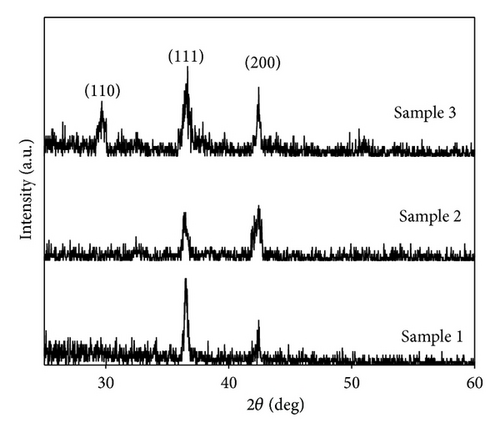
Figure 2 shows the FESEM micrographs of three set of samples which shows that the films grown on ITO substrate are uniform. The average grain size and thickness of the Cu2O films for the samples are shown in Table 1. The cross section of thin films was used to measure the thickness of the film while the grain size was measured from the FESEM micrograph. The grain size was reducing from 104 nm to 83 nm, after adding polyethylene glycol. The thickness of thin film increased with the addition of polyethylene glycol. It is shown that the addition of polyethylene glycol will increase the viscosity of solution due to chain length effects [13]. The spin coating rate also can affect the thickness of the thin film; lower spin coating rate produce much thicker film due to less solution spread out from substrate.
| Samples | Energy gap (eV) |
Grain size (nm) |
Thickness (nm) |
Plane (hkl) |
|---|---|---|---|---|
| 1 | 1.85 ± 0.1 | 104 | 102 | (111), (200) |
| 2 | 1.90 ± 0.1 | 83 | 395 | (111), (200) |
| 3 | 1.75 ± 0.1 | 90 | 59 | (110), (111), (200) |
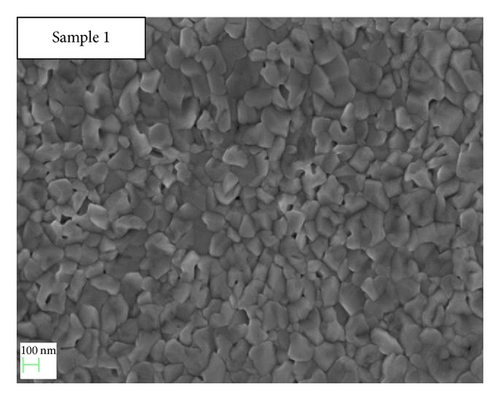
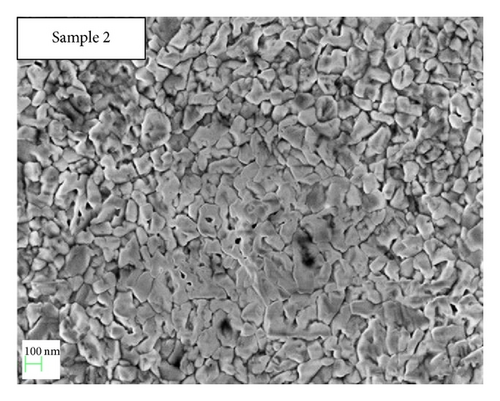
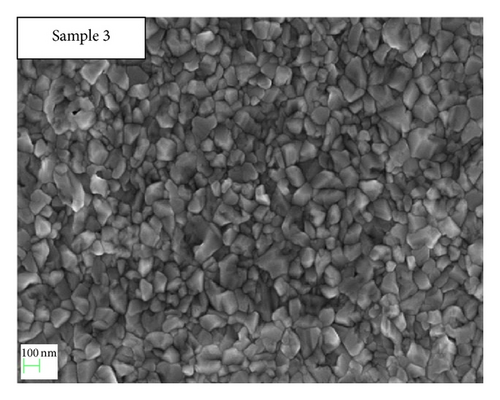
The addition of ethylene glycol has been widely used in the polyol synthesis of metal and metal oxide due to its strong reducing ability and relatively high boiling point (~ 197°C). Polyol synthesis of metal consists in the reduction of metal cation in a polyol medium. Over the past few years, polyols have also been used to elaborate a great variety of oxides [15, 16] and layered hydroxyl-salt [17] by means of hydrolysis and inorganic polymerization. The addition of ethylene glycol (sample 3) with thickness of 59 nm shows that the Cu2O grains were irregular in shape.
The UV-Vis spectra of different Cu2O samples are shown in Figure 3. The absorbance of samples may be influenced by grain size, thickness, shape, and the area of Cu2O films covered onto ITO coated glass. The films must totally cover the ITO coated glass. The highest absorbance at wavelength of 600–700 nm obtained for sample 2 is due to its maximum thickness and smallest grain size amongst other samples. This behavior agrees well with the earlier results published by Oral et al. [11]. There is a possibility of increasing of absorbance caused by scattering at grain size as reported by Ray [7]. The absorbance of sample 2 and sample 3 shows the same trend and the absorbance can be improved by increasing the thickness of films.
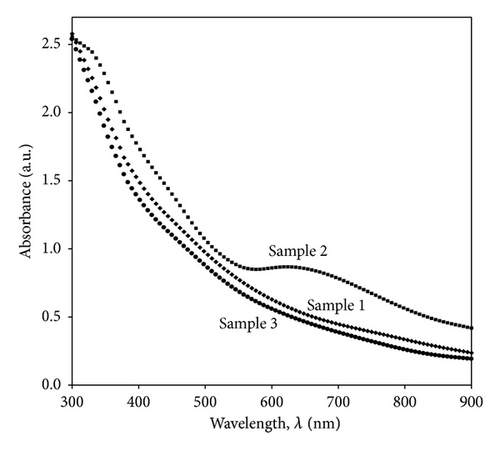
The Cu2O thin films were used as working electrodes in PESC of ITO/Cu2O/PVC-LiClO4/aluminum. The layer of PESC of ITO/Cu2O/PVC-LiClO4/aluminum was shown in Figure 4. Most of PESC reported used an aqueous solution of NaOH as an electrolyte. For PESC of ITO/Cu2O/PVC-LiClO4/aluminum, the solid polymer electrolyte of PVC-LiClO4 was used as an electrolyte. The total cell active area was 1.5 cm2. Figure 5 shows current-voltage (I-V) characteristics of the PESC, under dark and light illumination. The I-V characteristic of sample 1 was much different from that of sample 2 and sample 3 due to absence of the additive solutions during its preparation. Sample 2 (sample with polyethylene glycol) and sample 3 (sample with ethylene glycol) have an improvement of I-V characteristic because of the additive. This is the first reported demonstration of photoresponse from a deposited Cu2O thin film of ITO/Cu2O/PVC-LiClO4/aluminum. Open circuit voltages (Voc) and short circuit currents density (Jsc) of ITO/Cu2O/PVC-LiClO4/aluminum PESC were measured under light illumination of 100 mW/cm2 and shown in Table 2. The best Jsc and Voc obtained at 100 mW cm−2 were 3.2 × 10−11 mA/cm2 and 0.092 V, respectively, for sample 2 which was the thickest film and absorbed more energy from light. From the results shown in Table 2, it was found that Jsc obtained from this device is low. The ITO/Cu2O/PVC-LiClO4/aluminum current could be improved by depositing an organic dye onto the Cu2O films [18–20] as light sensitizer. This material will absorb a larger quantity of light in the visible region to excite more electrons from its molecule, so that it can be directly sent to the conduction band of Cu2O film upon illumination. Further studies are needed on ionic conductivity of the solid polymer electrolyte of PVC-LiClO4, surface morphology of Cu2O and aluminum films, light intensity, and temperature which influence the performance of the cells.
| Photoelectrochemical solar cell (PESC) | Jsc (mA/cm2) |
Voc (V) |
|---|---|---|
| Sample 1 | 1.9 × 10−11 | 0.090 |
| Sample 2 | 3.2 × 10−11 | 0.092 |
| Sample 3 | 1.0 × 10−11 | 0.080 |
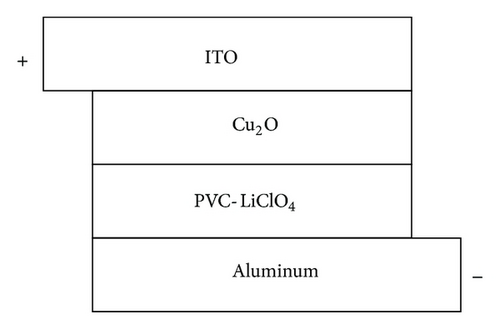

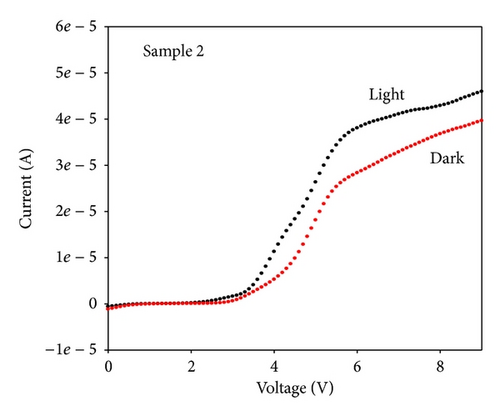
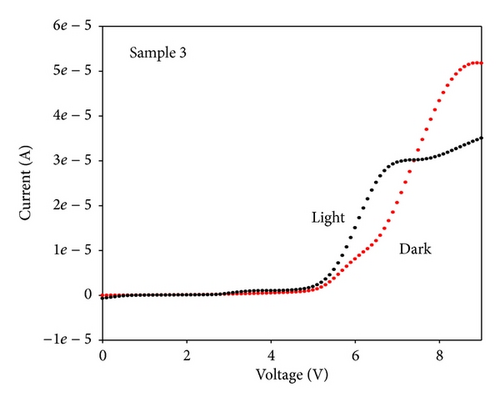
4. Conclusions
The Cu2O thin films were successfully grown onto ITO substrates by sol-gel spin coating with different additives and annealed at 350°C in 5% H2 + 95% N2 atmosphere. Various properties of Cu2O thin films have been characterized. The addition of polyethylene glycol to the parent solution can enhance various properties of the films, such as increasing optical absorbance, energy gap, and the thickness of films. These results indicate that the Cu2O thin film prepared by sol-gel spin coating technique using polyethylene glycol and ethylene glycol can be used for photoelectrochemical solar cell (PESC).
Conflict of Interests
The authors declare that there is no conflict of interests regarding the publication of this paper.
Acknowledgment
The authors gratefully acknowledge the financial support by MOSTI, through Science Fund Grant no. 03-01-02-SF0211.




